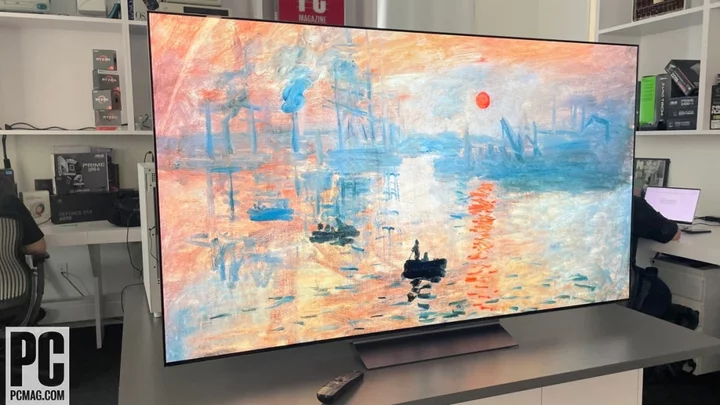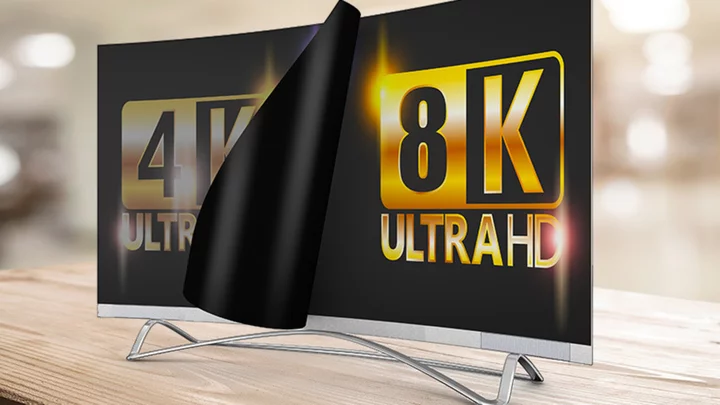LG’s C series of OLED TVs has stood out as one of our favorites for years, and the C3 Evo line is brighter and has slightly better color performance than its predecessor while delivering some of the lowest input lag we've measured. It would be a shoo-in for our Editors’ Choice award were it not for the Samsung S90C, which is even brighter and has a more future-proof design thanks to an over-the-air TV tuner. At $2,499.99 for the 65-inch version we tested, the C3 is slightly less expensive than the S90C ($2,599.99 for 65 inches), so both are worthy of your consideration.
A Typically Sleek Design
The C3 uses an OLED panel, so like all OLED TVs it has a slim and sleek design. The glass runs from edge to edge, with a quarter-inch-thick metal band running around the panel. The active picture is framed by a thin black border while the bottom edge is a slightly wider half-inch thick. A small rectangular bulge in the middle of the TV's bottom edge holds the infrared remote receiver, indicator LED, and far-field microphones. The screen can sit on the included rectangular metal table stand or be mounted on a wall.
(Credit: Will Greenwald)The permanently attached power cable extends from the center of the TV's rear panel, with all the other ports facing left. They include four HDMI ports (all 4K120, one eARC), three USB ports, two 3.5mm ports for RS-232C system integration and the included IR blaster cable, an Ethernet port, an optical audio output, and an antenna/cable connector.
LG hasn’t switched up its remote design from previous models and the included Magic Remote is nearly identical to the C2’s. It’s a thin, glossy black plastic wand with a slightly curved profile and a circular navigation pad in the middle that features a clickable scroll wheel rather than a button. Power and menu buttons, a number pad, volume and channel rockers, and a pinhole microphone sit above the navigation pad, while four color buttons and dedicated service buttons for Amazon Alexa, Amazon Prime Video, Disney+, LG Channels, Netflix, and Sling sit below.
(Credit: Will Greenwald)WebOS Remains a Capable Smart TV Interface
Like all LG TVs, the C3 uses the company’s WebOS smart TV platform. It’s a well-developed system that incorporates most major streaming services including Amazon Prime Video, Apple TV+, Disney+, Hulu, Max, Netflix, Twitch, and YouTube (though not Crunchyroll). It also supports Apple AirPlay for streaming from your iPad, iPhone, or Mac, and features hands-free Amazon Alexa voice assistant access thanks to the TV’s far-field microphones.
(Credit: Will Greenwald)Like Samsung’s Tizen smart TV platform, LG's WebOS lets the C3 serve as a smart home hub. The interface is LG-centric and primarily works with LG’s ThinQ-equipped appliances, though it also supports Matter-compatible devices along with a handful of smart lights, smart plugs, blind rollers, and thermostats from Bosch, Ikea, Philips, and TP-Link. Voice control works with any connected devices that support Alexa, but they won’t appear on the WebOS Home Hub screen or provide visual information like camera feeds.
Fantastic Color and Contrast
The LG C3 is a 4K OLED TV with a 120Hz refresh rate. It supports high dynamic range (HDR) content in Dolby Vision, HDR10, and hybrid log gamma (HLG). It has an ATSC tuner for broadcast TV, but not ATSC 3.0 for 4K broadcasts. This is disappointing when you consider that the much cheaper Hisense U8K ($1,699) supports ATSC 3.0, as does Samsung's competing S90C. For the price, a future-proof tuner should be part of the deal.
We test TVs with a Klein K-10A colorimeter, a Murideo SIX-G signal generator, and Portrait Displays’ Calman software. OLED TVs are universally less bright than high-end LED-backlit LCD TVs, but the technology has been steadily improving and the C3 puts out significantly more light than the C2.
Out of the box, in Cinema mode with an HDR signal, the C3 shows a peak brightness of 167 nits with a full-screen white field and 651 nits with an 18% white field. The 167 nits output is quite dim, but that’s unsurprising because the luminance of OLED panels drops off significantly when the entire panel is lit up. The 651 nits is much more respectable, exceeding the C2 (570 nits) and coming close to the Samsung S90C (726 nits). We use an 18% white field for consistent comparison of peak brightness across TVs, but the C3 can get much brighter with a 10% field, putting out 865 nits. The S90C is still brighter under those circumstances (1,025 nits), but both models are strong performers. Neither TV is nearly as bright as the Samsung S95C ($3,299), which puts out 889 nits with an 18% white field and a downright blazing 1,352 nits with a 10% field. Like all OLED TVs, the C3 shows perfect black levels and has an effectively infinite contrast ratio.
(Credit: PCMag)The above charts show the C3’s color levels in Cinema mode with an SDR signal compared with Rec.709 broadcast standards and with an HDR signal compared with DCI-P3 digital cinema standards. In both cases, the TV’s picture is almost ideal in range and accuracy. Whites are nearly spot-on, along with SDR colors and blues, cyans, magentas, and yellows in HDR. Greens and reds are well saturated, even if they drift just a bit outside of their boxes. The Samsung S90C’s color levels are a touch more accurate, but its whites run slightly cooler than they should.
The nature footage in BBC’s Dynasties looks excellent on the C3. In the “Emperor” episode, the whites of the snow and penguin bellies look natural, and the blacks of penguin heads are deep and dark while still showing their equally black eyes distinctly. In the “Lion” episode, the daytime savannah and clear sky look bright, and the greens of grass and tan yellow lion fur are well balanced. Fine detail in fur can be seen clearly under all lighting. In stormy shots with trees silhouetted against the sky, the bark is plainly visible on the trunks while still remaining almost completely black.
Demonstration footage on the Spears & Munsil Ultra HD Benchmark is just as impressive, with dark forests at dawn and dusk still revealing detail, and sunrises and daytime shots appearing bright. Colors from the blues of water to the ambers of honey are vivid and balanced. Colorful objects in front of black backgrounds pop, with the backgrounds themselves showing no light at all.
The Great Gatsby looks fantastic on the C3 thanks to the OLED panel’s incredible contrast. In the party scenes, the whites of balloons, lights, and shirts appear bright, while the cuts, contours, and textures of black suits and dark hair are properly dark and can be seen clearly, with extensive shadow detail preserved in each shot.
Gamers Will Love the Low Input Lag
Besides rich contrast and color, OLED TVs offer superlative gaming performance. Until now, most OLED TVs we've tested have shown an input lag of around 2ms. Recently, however, two OLED TVs have beaten that mark with readings of less than a millisecond. The HDFury 4K Diva HDMI matrix we use for input lag testing gave us error responses (rather than actual readings) indicating sub-millisecond measurements for both the LG C3 and the Samsung S90C in their respective Game modes. For the C3, that rating was when we turned on the TV’s Game Optimizer feature and set the input lag reduction to Boost. When we changed the input lag setting to Standard, we recorded an input lag of 4.9ms, and with the Game Optimizer completely turned off it jumped to 80.4ms. Obviously, sub-1ms speeds make the LG C3 one of the best TVs for gaming alongside the Samsung S90C.
In addition to the extremely low latency, the C3 features a 120Hz refresh rate with variable refresh rate (VRR) support, as well as both AMD FreeSync and Nvidia G-Sync compatibility (though no formal certification). The Game Optimizer mode also enables a quick menu that shows what gaming features are active when you’re playing.
Another Excellent OLED From LG
The LG C3 Evo is a fantastic TV with an incredible picture and stellar gaming performance. It runs neck and neck with the Samsung S90C as one of the most well-rounded OLED TVs available in terms of quality and value. Plus, it's a little less expensive than the S90C and we prefer LG’s smart TV platform over Samsung’s. Still, the S90C has an edge with its 4K-capable ATSC 3.0 tuner and slightly brighter panel, which is why it remains our Editors’ Choice winner. Finally, if you're willing to shell out for the absolute best OLED TV available, the Samsung S95C is our Editors' Choice for high-end models thanks to its class-leading brightness.









